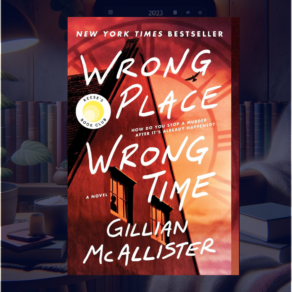Diving into Neil Gaiman’s enchanting world of mystery, memory, and magic, “The Ocean at the End of the Lane” offers readers a unique blend of childhood innocence and the dark complexities of adulthood. In this post, we’ll delve into an extended summary of the novel, introducing you to its mesmerizing characters who play pivotal roles in weaving this intricate tapestry of fantasy and reality.
Following the summary, we’ll meet the inhabitants of this narrative—the Hempstock family and their unlikely companion, our unnamed protagonist, among others, who together explore themes of friendship, fear, and the fantastical.
To enrich your reading experience or to facilitate a lively discussion in your next book club meeting, we will also provide thought-provoking questions that delve into the novel’s core themes and the profound messages Gaiman intricately embeds within the narrative.
Related: Best The Ocean at the End of the Lane Quotes
The Ocean at the End of the Lane Summary
Neil Gaiman’s “The Ocean at the End of the Lane” is a mesmerizing exploration into the depths of memory, magic, and the complexities of human emotion, wrapped in the comforting cloak of a fairy tale. Published on June 18, 2013, this novel marks Gaiman’s triumphant return to adult literature following his highly acclaimed work, “Anansi Boys.”
The story begins with an unnamed protagonist who returns to his hometown for a funeral. Driven by an inexplicable pull, he finds himself at the end of the lane, by a farmhouse that hints at the edges of his memory. Here, he reminisces about events that unfolded during his childhood, events that are as magical as they are menacing.
The farm at the end of the lane is home to the Hempstock family—three generations of women (Lettie, her mother, and grandmother) who possess an uncanny connection to the mystical. The young boy, befriending Lettie, is thrust into an adventure that transcends the limits of his previously understood reality. The pond that Lettie claims is an ocean becomes the epicenter of their journey, a symbolic representation of the vast, unexplored depths of the human psyche and the universe.
Photo: Amazon
Gaiman’s narrative is a delicate weave of terror and wonder, exploring themes of loneliness, friendship, and the resilience of the human spirit in the face of otherworldly forces. The antagonist, a chilling embodiment of primal fears and desires, brings to light the darker aspects of human nature and the universe. Yet, the warmth of the Hempstock family offers a counterbalance, showcasing the power of kindness, understanding, and the unbreakable bonds that define our existence.
“The Ocean at the End of the Lane” is more than just a fairy tale; it’s a profound reflection on the nature of memory and the often overlooked magic woven into the fabric of our lives. Gaiman challenges readers to question the reality of their recollections and to acknowledge the thin veil that separates the mundane from the magical. His masterful storytelling, rich with metaphor and emotion, invites a deeper contemplation of the stories we tell ourselves and the truths we choose to believe.
The Ocean at the End of the Lane Characters
In Neil Gaiman’s “The Ocean at the End of the Lane,” the characters are as richly drawn as the story itself, each bringing depth and complexity to this enchanting narrative. Here’s a closer look at some of the key characters:
- The Narrator: The story is told from the perspective of an unnamed middle-aged man who returns to his childhood hometown for a funeral. His journey back triggers a flood of long-buried memories, especially those involving a mysterious event from his childhood. The narrator serves as a bridge between the reader and the magical world Gaiman crafts, his reflections and experiences tinged with nostalgia and the innocence of youth.
- Lettie Hempstock: A pivotal figure in the narrator’s childhood adventure, Lettie is a remarkable girl who claims her family’s pond is an ocean. Wise beyond her years, she is part of the enigmatic Hempstock family, who seem to exist outside of time and possess an intimate understanding of the universe’s deeper truths. Lettie is brave, kind, and the narrator’s guide into the supernatural realm that intersects with the mundane world.
- Old Mrs. Hempstock: Lettie’s grandmother, a wise and powerful matriarch who has a deep connection to the mystical forces that surround their farm. She embodies ancient wisdom and possesses abilities that hint at her otherworldly origins. Old Mrs. Hempstock plays a crucial role in helping the narrator confront the dark forces unleashed upon their world.
- Ginnie Hempstock: Lettie’s mother, who is also endowed with magical abilities and knowledge. Like her mother and daughter, Ginnie is nurturing and protective, offering her own kind of support and guidance to the narrator during his trials.
- Ursula Monkton: The antagonist of the story, Ursula Monkton is a malevolent force that takes on the guise of a human to infiltrate the narrator’s life. Her presence brings chaos and danger, representing the narrator’s fears and the darker aspects of human nature. Ursula is a complex character, whose seductive malevolence challenges the narrator’s understanding of good and evil.
- The Narrator’s Family: The narrator’s family, including his parents and sister, play a significant but more background role in the story. His relationship with them, particularly the strains and challenges they face due to financial difficulties and the intrusion of Ursula Monkton, highlights the complexities of familial bonds and the innocence lost as one transitions from childhood to adulthood.
The Ocean at the End of the Lane Book Club Questions
Here are some questions that can guide your book club’s conversation:
- Themes of Memory and Reality: How does Gaiman play with the themes of memory and reality in the novel? Discuss how the protagonist’s adult perspectives influence his childhood memories. Do you think his memories are reliable or altered by his adult understanding?
- Character Analysis: Consider the characters of the Hempstock women—Lettie, her mother, and grandmother. How do they differ from each other, and what do they collectively represent in the story? How do their wisdom and actions influence the protagonist’s journey?
- The Antagonist’s Influence: The antagonist in the story, Ursula Monkton, is both fascinating and terrifying. What do you think she represents? Discuss how her character affects the family dynamics of the protagonist and the overall story.
- Symbolism of the Ocean: The pond that Lettie claims is an ocean is a central symbol in the book. What do you think this ocean represents? How does this symbolism affect your interpretation of the story’s themes, such as the depth of memory and the unknown?
- Childhood Innocence vs. Adult Complexity: How does Gaiman contrast the innocence of childhood with the complexity and often harsh reality of adulthood? How does this contrast affect the protagonist’s understanding of the world and himself?
- The Role of Fear: Fear plays a significant role in the novel, both in its fantastical elements and in the more mundane aspects of life. How do the characters confront their fears, and what does the book suggest about the nature of fear itself?
- Narrative Style and Structure: Discuss Gaiman’s narrative style and how it contributes to the atmosphere of the novel. How does the blending of fantasy and reality impact your reading experience?
- Impact of the Setting: The English countryside, particularly the lane and the Hempstock farm, are almost characters in their own right. How does the setting influence the story? How does it contribute to the sense of wonder and menace?
- Themes of Survival and Protection: In what ways do the themes of survival and protection manifest in the novel? How do the characters protect themselves and each other from the various threats they face?
- Personal Reflections: Were there any moments in the book that resonated with you personally? Have you ever had a “Lettie Hempstock” in your life, someone who introduced you to a world beyond the ordinary?
Related: She Who Became The Sun Summary
Final thoughts
Neil Gaiman’s “The Ocean at the End of the Lane” is a profound narrative that masterfully blends elements of fantasy with the realities of human emotion and memory. Gaiman’s narrative invites us into a world where the boundaries of reality are blurred, reminding us of the power of stories to shape our perceptions and understanding of the world around us.









